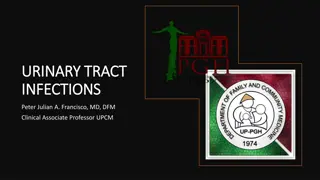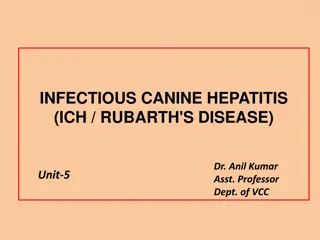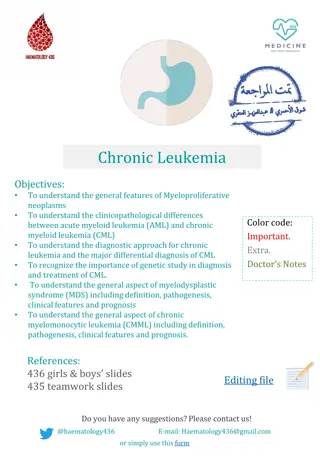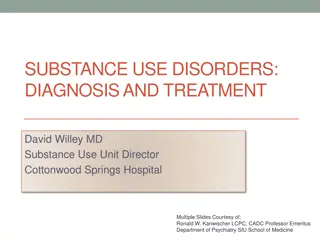Overview of Acute Pyelonephritis: Diagnosis, Treatment, and Epidemiology
Acute pyelonephritis is a serious bacterial infection of the kidneys, leading to complications such as renal scarring and sepsis. This overview covers key aspects including epidemiology, etiology, clinical presentations, and risk factors. Diagnosis, treatment, and prevention strategies are also discussed, highlighting the importance of early recognition and management to prevent severe outcomes.
Download Presentation

Please find below an Image/Link to download the presentation.
The content on the website is provided AS IS for your information and personal use only. It may not be sold, licensed, or shared on other websites without obtaining consent from the author. Download presentation by click this link. If you encounter any issues during the download, it is possible that the publisher has removed the file from their server.
E N D
Presentation Transcript
Acute Pyelonephritis PROF. ALI SOMILY, MD, FRCPC
Objectives Introduction Epidemiology Definition Etiology Pathogenesis Pathology Clinical presentations Diagnosis Treatment and prevention Other Syndromes
UTI Terminology Uncomplicated: infection of urinary bladder in host w/out underlying renal or neurologic disease. Complicated: infection in setting of underlying structural, medical or neurologic disease. Recurrent: > 2 symptomatic UTIs w/in 12 mos. following clinical resolution of each previous UTI after therapy. Reinfection: recurrent UTI caused by different pathogen at any time or original infecting strain >13 days after therapy of original UTI. Relapse: recurrent UTI caused by same species causing original UTI w/in 2 weeks after therapy.
Introduction It is very serious condition that lead to renal scarring, nephric, perinephric abscess formation, sepsis Clinical presentation is atypical in some patients Update on the management
Prevalence of bacteriuria in different age groups 30 25 20 female male 15 10 5 0 0-3 4 14 15-29 30-64 65-85 >85
Risk Factors Pregnancy (1/2 of asymptomatic will develop pyelonephritis if not treated) Diabetes (10 time more admission) Immunosuppression Obstruction Catheterized patients
Definition It is Bacterial infection of the renal pelvis, tubules and interstitial tissue of one or both kidneys - Renal pelvis: pyelitis pyelonephritis - Bladder: cystitis - Urethra: urethritis - Renal parenchyma:
Etiology Escherichia coli, which accounts for 70-90% of uncomplicated UTIs and 21-54% of complicated UTIs. the uropathogenic E. coli (UPEC) erives commonly from the phylogenetic groups B2 and D, which express distinctive O, K, and H antigens. UPEC genes encode several postulated virulence factors (VFs), including adhesins P fimbriae pap+genotype family, protectins, siderophores, and toxins. Staphylococcus saprophyticus, Klebsiella pneumoniae, Proteus mirabilis, enterococci, Staphylococcus aureus, Pseudomonas aeruginosa, and Enterobacter species. Rare candida, viruses, brucella and TB. Host factors.
Pathogenesis Ascending bacterial infection Hematogenous spread to kidney is rare Exception: neonates with Staphylococcus aureus For optimal host defense function, intermittent & complete emptying of bladder must occur Urine is excellent culture medium Bactericidal secretion from uroepithelial cells and glycoproteins inhibit bacterial adherence Renal parenchyma infections result in inflammatory response to contain infection but contributes to potential scarring
Pathology Kidneys enlarge Interstitial infiltration of inflammatory cells Abscesses on the capsule and at corticomedullary junction Result in destruction of tubules and the glomeruli When chronic, kidneys become scarred, contracted and nonfunctioning
Symptoms and Signs Acute pyelonephritis may be unilateral or bilateral Flank pain(pain in the costovertebral angle )or tenderness or both, fever, chill and lower urinary tract symptoms(urgency, frequency and dysuria) Azotemia can occur Other non infectious causes of these symptoms is renal infarct and caliculi .
In the chronic phase the patient may show unremarkable symptoms such as nausea and general malaise Systemic signs occur as a result of the chronic disease: elevated BP, vomiting, diarrhea.
Differential Diagnosis One fifth of the patients Acute pelvic inflammatory disease Ectopic pregnancy Diverticulitis Renal calculi
Complications Hypertension, septic shock, multi organs failure, death Renal or prinephric abscesses Metastatic infection Papillary necrosis Acute renal failure Emphysematous pyelonephritis Renal gangrene Localized or generalized atrophy/permanent loss of function
Diagnosis Diagnosis is confirmed by bacteria (108/l or 105/ml) and pus >= 10/HPF (90%)and leukocytes esterase , RBCS 20- 40% in the urine and leukocytosis A clean-catch or catheterized urinalysis with quantitative culture on BAP and selective media and sensitivity identifies the pathogen and determines appropriate antimicrobial therapy Blood culture 15-30% BUN and Creatinine levels of the blood and urine may be used to monitor kidney function IVP will Identify the presence of obstruction or degenerative changes caused by the infection process Ultrasound or CT scan
Management Patients with mild signs and symptoms may be treated on an outpatient basis with antibiotics for 7- 14 days Hospitalization in sever cases Empirical treatment is TMP-SMX (Resistance around 50%), fluoroquinolones is alternative Ampicillin with aminoglycoside or third generation cephalosporins, pipracillin or carbapenems in sever cases Antibiotics are selected according to results of urinalysis culture and sensitivity and may include broad-spectrum medications
Prevention Antimicrobial prophylaxis TMP-SMX or fluoroquinolones 3/week or nitrofurantoin daily Intravaginal estradiol 300 ml of cranberry juice Removal the urinary catheter as soon as possible or use condom catheter
Prognosis Prognosis is dependent upon early detection and successful treatment. Baseline assessment for every patient must include urinary assessment because pyelonephritis may occur as a primary or secondary disorder.

















































